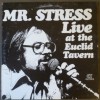 The Washington Post reports that fifty-four prominent journalists are recommending that a Pulitzer Prize be awarded to the late Ed Kennedy, nearly seventy years after the American journalist first revealed to English-language readers the news of Germany’s surrender to the Allies in WWII. Sadly, rather than receiving laurels for his scoop, Kennedy’s press credentials were withdrawn by the American military for breaking their embargo on this information, and he was later fired by the Associated Press. Kennedy had broken the ban after learning that the information was being held not for security reasons, but so that Joseph Stalin could “stage a signing ceremony of his own to claim partial credit for the surrender, and U.S. officials were interested in helping him have his moment of glory.” When he next learned that news of the historic surrender had already been broadcast on German radio, Kennedy, then in France, found a phone that he knew was “not being monitored by military censors,” and transmitted this message to AP editors in London: “Germany has surrendered unconditionally.”
The Washington Post reports that fifty-four prominent journalists are recommending that a Pulitzer Prize be awarded to the late Ed Kennedy, nearly seventy years after the American journalist first revealed to English-language readers the news of Germany’s surrender to the Allies in WWII. Sadly, rather than receiving laurels for his scoop, Kennedy’s press credentials were withdrawn by the American military for breaking their embargo on this information, and he was later fired by the Associated Press. Kennedy had broken the ban after learning that the information was being held not for security reasons, but so that Joseph Stalin could “stage a signing ceremony of his own to claim partial credit for the surrender, and U.S. officials were interested in helping him have his moment of glory.” When he next learned that news of the historic surrender had already been broadcast on German radio, Kennedy, then in France, found a phone that he knew was “not being monitored by military censors,” and transmitted this message to AP editors in London: “Germany has surrendered unconditionally.”
According to the Post‘s Manuel Froig-Ranzia, “Kennedy’s story ran big in newspapers around the world. It should have been his greatest moment, but it became an ordeal. The military revoked his credentials, but that was the least of the indignities. His fellow correspondents turned on him, voting 54 to 2 to condemn him. And the head of AP— the Philadelphia Bulletin’s publisher, Robert McLean—apologized for Kennedy’s report rather than praising him.” Like a schoolboy called on the carpet, “Kennedy was summoned back to AP headquarters, where his bosses refused to accept his resignation but also refused to give him any work. Several months later, he discovered more than $4,000 in his checking account—it was a severance, though no one had the courtesy to tell him he was being fired.
Kennedy died in 1963, at age fifty-eight, leaving behind his wife, Lyn Crost, also a former war correspondent, and daughter Julia, who would later become a journalist, as well. She told Froig-Ranzia that the AP fired her father “in the most cowardly way.” After his death, a book-length manuscript surfaced that he’d completed in 1951, for which he’d never been able to find a publisher. Froig-Ranzia reports that,
“Over the years, Cochran tried to read it. But she could never finish it. It was too painful to recall the father she’d lost when she was just 16. She kept it packed away for more than 40 years, through marriage and divorce and a career change. Eventually, in retirement, she found time to read it anew and to gain a deeper understanding of the father she’d lost. She set about searching for someone who would let her father tell his story. The publisher she found—Louisiana State University Press—didn’t tell her who they’d asked to write the introduction. It was Curley, the AP president [nowadays]. She was ‘overjoyed’ when she read what he’d written, sentiments that he said Kennedy’s former bosses and AP’s board of that era ‘could not admit.’
“Edward Kennedy,” Curley wrote, “was the embodiment of the highest aspirations of the Associated Press and American journalism.”
The book, Ed Kennedy’s War: V-E Day, Censorship, and the Associated Press, was published in May of this year, and Cochran is making appearances in support of the book. Among its supporters is Sydney Schanberg, who wrote this in his endorsement of the book, “Ed Kennedy’s AP war stories were smoothly written, full of flowing English and rich in detail. He was the kind of reporter who made his readers feel they were there with him on the scene. This fascinating memoir was written by a gifted war correspondent.”
I am eager to read Ed Kennedy’s War, and hopeful that the Pulitzer committee will redress the wrong that was done to him by recognizing him with a belated award.
 Readers of this blog will recall that I contributed an essay, “Remembering Mr. Stress, Live at The Euclid Tavern,” to Rust Belt Chic: A Cleveland Anthology. Co-editor Anne Trubek reports that the book is selling well, in its ebook and trade paperback editions, and is frequently being reordered by book retailers including Amazon.com. Anne posted news on Facebook tonight that the Nook, Apple, and Kindle ebook editions are right now being sold in the respective digital stores for the terrific price of $2.99 (Nook store, ITunes store, and Kindle store)
Readers of this blog will recall that I contributed an essay, “Remembering Mr. Stress, Live at The Euclid Tavern,” to Rust Belt Chic: A Cleveland Anthology. Co-editor Anne Trubek reports that the book is selling well, in its ebook and trade paperback editions, and is frequently being reordered by book retailers including Amazon.com. Anne posted news on Facebook tonight that the Nook, Apple, and Kindle ebook editions are right now being sold in the respective digital stores for the terrific price of $2.99 (Nook store, ITunes store, and Kindle store)


